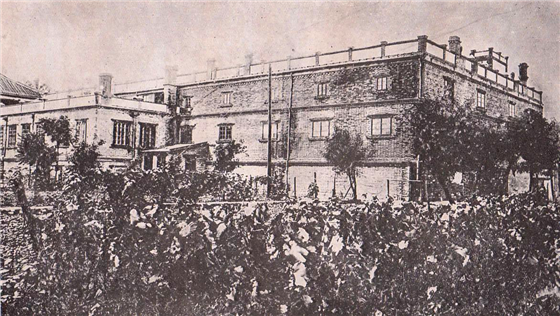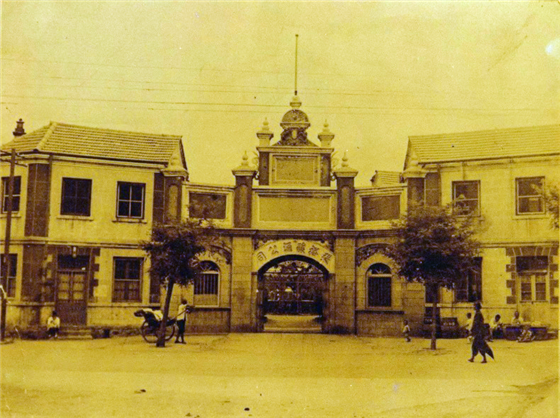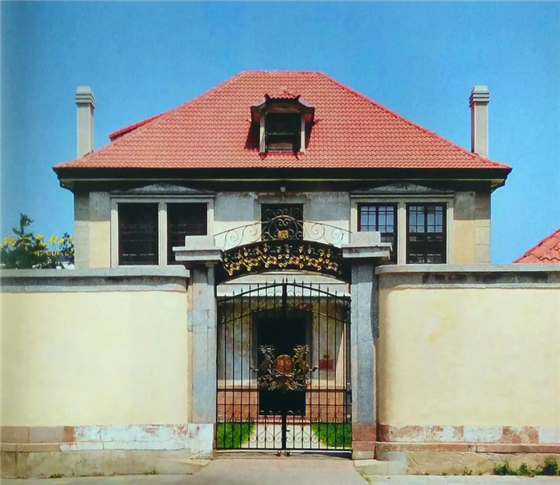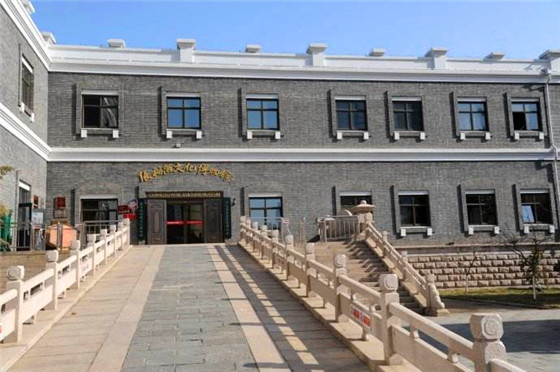
Changyu listed as national industrial heritage
Yantai Changyu Pioneer Wine Co has ranked top among the first batch of the National Industrial Heritages recently announced by the Ministry of Industry and Information Technology.
Yantai Changyu Pioneer Wine Co has ranked top among the first batch of the National Industrial Heritages recently announced by the Ministry of Industry and Information Technology.
According to the ministry, industrial heritage is an important carrier of industrial culture, which has recorded the important information of various stages of China's industrial development, and witnessed the evolution of the country and its industries. It is of great historical value, scientific value, social cultural value, and artistic value.

The early factory of Changyu winery. [Photo/Xinhua]
Changyu, the only Shandong-based company on the list, has 11 core items developed over the course of China's modern wine making history. The items include the Underground Grand Cellar, the old gate of Changyu Pioneer Wine Co, the stone stele of Changyu Road and the stone boundary monument of Changyu, 1892 Club (former residence of Chang Bishi) and Changyu Treasury, King of Barrel in Asia and imported oak barrels in Qing Dynasty (1644-1911), plate and frame filter, distiller, gold star Cognac Brandy, Sun Yat-sen's inscription for Changyu "Pin Zhong Li Quan" in 1912, gold medals of Panama-Pacific International Exposition in 1915, and the brand registration certificate of "Cabernet" in 1937.
Changyu's historical significance has been well-recorded in the more than 100 years that the company has been in operation.
The Overview of Yantai Changyu Pioneer Wine Co published in a business newspaper in 1907 introduced that Changyu's Underground Grand Cellar was first built in the spring of 1896, and was rebuilt in 1902 and 1904 and finally completed in 1905.The Survey Report about Yantai Changyu Pioneer Wine Co published in the Shandong Agricultural and Mineral Department Communique in 1930 described that the cellar covers an area of 4 mu (0.27 hectares), is about 10 meters underground, and has 30 long alleys inside.

According to The Past of Changyu published in 1999, the old gate of Changyu was engraved with the company's name "Changyu Pioneer Wine Co" by Weng Tongsu, an official of late Qing Dynasty (1644-1911). On the gate is also engraved the company's philosophy "making various fine wine with western techniques". Above its philosophy is written "Fine Selections Wine from Western Style".

According to the Survey on Yantai published in The Guide Weekly in 1924, Yantai once had a road named Changyu Road, but Changyu Pioneer Wine Co was located at the Dama Road. A researcher at the Changyu Wine Culture Museum said that Changyu invested in the road in front of its gate at its early stages in order to make it more convenient for the delivery of grapes from vineyard to the company. The road was then called "Changyu Road" by local citizens, renamed Zhangyu Road in 1936, later becoming Jiefang Road in 1948 until now.
The stone boundary monuments of Changyu, including monuments for Changyu Wine Store and monuments for Changyu Co, were founded in different periods. The Guide Weekly said that the company was founded by Chang Bishi, who established buildings and cellars of more than 60 mu, and built vineyards covering thousands of mu.
The 1892 Club (former residence of Chang Bishi, Changyu's founder) was located on the east of the original site of Changyu Pioneer Wine Co. A picture book Changyu Wine Culture Museum published by the China Travel and Tourism Press in 2012 said, "the 1892 Club, covering about 900 square meters, is a building of brick and concrete structure and in the western style."

The Changyu Treasury was located on the west of the "International Vine and Wine City" Memorial Sculpture Square at the Changyu Wine Culture Museum.
According to the picture book, the treasury was used to store the money used for construction, purchasing and marketing in the early stages of the company's history. It reflected the characteristics of currency circulation at that time and served as a symbol of Changyu's prosperity. It was said that the underground treasury was a secret known only by the general manager and accountant at that time.
The Brewing Industry in Yantai published in Economic Research in 1940 described the company's cellar as being able to "store a maximum of 6 million liters of wine", and that "it now has more than 600 barrels capable of storing over 1 million liters of wine".
The same publication noted, "The barrels were bought from Europe. The most expensive barrel cost 6,000 yuan ($923), able to store 15,000 liters of wine. The barrels were made of white oak, which was firm and helped wine grow mature and produced better brandy."
Changyu's Underground Grand Cellar still has three giant oak barrels that can store 15,000 liters of wine, called the King of Barrels of Asia, and attracts a large number of visitors.
Filtration is a technique to make wine clearer. Changyu was appointed by the textbook office of Ministry of Labour to compile a textbook Wine Making Technique published in 1995. The textbook stated, "The plate and frame filter is an advanced filtration and degerming device. It is small, efficient, and easy to use. It can be widely applied, has good corrosion resistance property, and can be used for a long time."
Distillation is a key step to turn wine into brandy. A scientific magazine published in 1940 said, "Changyu wine is made of pure grape juice, and Changyu brandy is distilled from grape wine." Changyu Wine Culture Museum still preserves an old rusty distiller. Although it is broken, its features remain obvious. It is a standard handmade Alembic Charentais pot distiller made of copper.
An advertisement Changyu First Uses Western Technique to Make Wine published in Fiction Monthly in 1918 showed that the company's most expensive product was Cognac Brandy, at 24 yuan a dozen. The most expensive white wine was Traminer, 18 yuan a dozen. The most expensive red wine was Cabernet Franc, 14 yuan a dozen. The English label of Cognac Brandy was Chefoo Cognac. China started its geographical indicator protection for Cognac in 2009.
Later, Changyu's Cognac Brandy was divided into gold star cognac and red star cognac. Currently, Changyu Wine Culture Museum preserves a bottle of gold star Cognac Brandy made in 1928.
The high school textbook Modern and Contemporary Chinese History published by the People's Education Press includes a picture of Sun Yat-sen's inscription for Changyu "Pin Zhong Li Quan" written on Aug 21, 1912. The caption of the picture was "Overseas Chinese businessman Chang Bishi founded Changyu Pioneer Wine Co in Yantai. And Sun Yat-sen has written an inscription for the company".

At the Panama-Pacific International Exposition held in the San Francisco in 1915, Changyu's products Keya Brandy, Chefoo Red Rose Wine, Vermouth and Riesling Dry White Wine won gold medals. According to the winning list of Chinese companies attending the Panama-Pacific International Exposition compiled by Chen Qi, an official at the Ministry of Agriculture and Commerce, Changyu wine was the only one that took prizes in the name of a company among all the winning Chinese liquor.
Also, according to a book published in San Francisco in 1915 about Chen Qi feting US envoy to China Paul Samuel Reinsch, a special agent of US government Lama, and Chinese envoy to Mexico Gu Weijun, the feast was accompanied by Chinese instruments. And Changyu wine, both smelling and tasting good, was greatly praised by the westerners. All the guests who tasted the wine were fascinated.
On Nov 19, 2017, the promotional film of Changyu's ninth generation Cabernet debuted in Times Square. It is reported that Changyu's Cabernet has been sold in more than 5,000 European supermarkets. Its global sales are expected to exceed 490 million bottles. René Gabriel, chief editor of a Swedish magazine WEINWISSER once commented Changyu's Cabernet, "This excellent Chinese wine shows that even large-scale produced wine can have excellent quality and reasonable price."
Changyu's industrial heritage has witnessed a centennial of development. The company hasn't buried this heritage in dust, but vitalized it and incorporated it into the system of Changyu wine industrial tourism.
Changyu has also made it onto the list of China National Industrial Tourism Demonstration Bases released by the China National Tourism Administration in November. The winemaker's industrial tourism system has become a key channel for consumers to know the history and culture of Chinese wine.